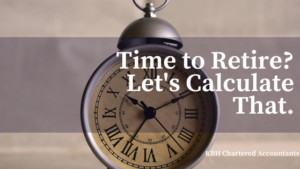We’ve been trending with the retirement posts lately; especially with the RRSP contribution deadline looming (you’re probably getting tired of hearing us say it; it’s March 1st by the way!). But if your personal finances keep you up at night and you’re constantly wondering “how much do I actually need to retire?”, then you should take some notes.
The amount you need to have saved to retire comfortably, with the same quality of life you’re currently leading, varies for everyone — you need to ask yourself how much you want to set aside for travelling, will you stay in the same house or down size, will you keep both vehicles, will you continue to invest? These things, along with a multitude of others, need to be taken into consideration.
So the question is: are you truly saving enough to get yourself ready for retirement?
We’re going to stick with a concrete example for this… Meet Beverly. Beverly is a business owner in Alberta and has a salary of $100,000 a year (we’re not worrying too much about inflation right now). Beverly takes home around $5,950 monthly and has been contributing to her RRSPs since she was 25 years old, hoping to retire at 65.
For this example, Beverly puts away $10,000 into her RRSP every year and earns an assumed rate of return of 3.5%. By the time she is 65, Beverly will manage to save about $873,000 — assuming she does not make any early withdrawals.
Now that Beverly has a rough estimate of what she’ll have saved, it’s important to begin calculating expenses. In the end, the figure you need to have before doing any legitimate retirement math should be an estimate of your assumed retirement living expenses. New roofs are expensive… same with hip surgery. So how can you plan for this?
Taking into account housing, property taxes, utilities, food, clothing, entertainment and travel, along with a variety of other costs, Beverly assumes she will need about $60,000 per year during her retirement to live comfortably. Historically, the “rule of thumb” has been that you’ll require around 70-80% of your income to live comfortably; however, financial experts can never truly seem to agree on what that percentage should be. Some have even suggested as low as 50%. In the end, that percentage depends solely on the lifestyle you wish to maintain. For Beverly, her math put her at about 77% when you consider income taxes.
Lets assume Beverly needs her retirement funds to last for 25 years after she retires. At an annual pre-tax income of $100,000 Beverly has likely contributed close to the maximum amount to her Canadian Pension Plan (CPP); therefore, we have assumed she will receive a little more than the average CPP benefit but also a little less than the maximum pension of $1,134/month during her retirement.
If Beverly receives the maximum Old Age Security (OAS) amount of $585/month and $1,000/month from CPP, she is receiving $1,585 every month, or $19,020 annually. Beverly’s estimated retirement expenses are $60,000; therefore, she will need to withdraw $40,980 (before considering income taxes) every year from her RRSP.
We previously stated that by the time Beverly retired at 65 years old she would have about $873,000 in her RRSP. When taking into account income taxes on her CPP, OAS and RRSP withdrawals Beverly will need annual withdrawals of about $58,000 from her RRSP. This amount along with her CPP and OAS income will provide her with after tax funds of $60,000. Assuming she continues to earn an average rate of 3.5% during her retirement, Beverly will have about 22 years’ worth of funds in her RRSP. This is not enough!
Now if instead of 3.5% Beverly has an average rate of return of 4%, her RRSP will fund almost 29 years of retirement. Alternatively if Beverly increased her annual RRSP contributions by an extra $800 per year while continuing to earn 3.5%, she will have almost 27 years’ worth of funds.
Keep in mind that there are a significant number of variables that come into play with retirement planning: inflation, income tax rates, investment returns, and income needs to name but a few. Small changes in contributions, rates of return, and spending can all have a significant impact on your retirement plan!
In the end, it’s best you speak to a financial advisor — KBH can help you out with that! Contact us with any retirement planning questions and we would be happy to assist.
The numbers presented above are for illustration purposes only and certain assumptions have been incorporated into the calculations. Each individual situation will be unique and requires independent analysis.
